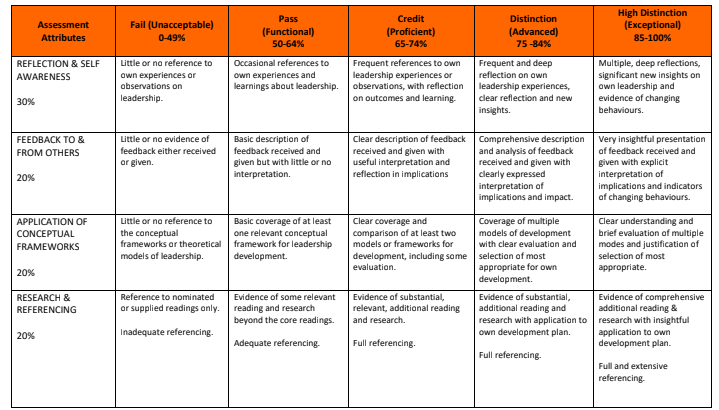Instructions to students: This is an individual assignment.
Length: Up to 2,000 words.
Weighting: 30%
Total Marks: 30 marks
Task: MGT601 Dynamic Leadership Assignment

Learning Outcomes:
a) Explore and reflect on self- development as a leader to build self-awareness
b) Through critical reflection on key leadership theories develop a personal leadership development strategy.
c) Analyse and develop the capacity to influence, motivate and inspire others in your workplace and/or community organisations.
Context:
The learning design of this subject is to focus on your own leadership journey and not to study leadership as some remote, theoretical concept that applies to other people. This
assessment enables you to build self-awareness and a clear sense of how you came to be
the person and emerging leader that you are today. It encourages deep reflection on your
life and leadership journey to your present position. It helps you to increase your
understanding of your current leadership capabilities and potential. The assessment
requires you to establish a mentoring relationship with another student in the class so that
you can provide mutual learning support and exchange constructive feedback with each
other.
Your Task:
Your task is to reflect on you own leadership journey up until now, your current role or position, how you influence others, how you lead, contribute to or react to organisational and cultural changes and your current level of self-awareness and self- confidence to lead others in your organisation and/or community.
This Assessment is due at the end of the subject, builds on the first and asks you to prepare a plan for the next stage of your leadership journey. The assessments are integrated pieces of work and you should bear in mind the final part as you work on this part. All assessments need to be strongly based on the established theories and models of leadership to help you interpret and explain your leadership challenges.
Working with Your Partner:
Partners will be allocated by your Learning Facilitator after you post your personal introduction on the “Welcome and Introductions” Discussion Forum. Partners will
be allocated on the basis of maximum diversity of backgrounds to enrich your
learning experience. Where possible, partners will be in similar time zones. More
detailed guidelines for working with your partner are provided at the end of this
section.
You should include a summary of the feedback you receive from your partner and others, combined with your reflection and interpretation of this feedback in the context of your leadership journey.
You may wish to also include a summary of the feedback that you gave your partner and reflect on it. Feedback often says as much about the person who gives as the person who receives it. The feedback summaries can be included as appendices, where they will not be included in the word count.
While the assessment includes feedback from the interaction with your partner, each person is to submit his or her own, individual report.
More detailed guidelines for working with your partner are shown at the end of this brief.
ORDER This SNPG962 MGT601 Dynamic Leadership Assignment NOW And Get Instant Discount
Possible Structure:
A possible structure for your report is shown below. This is a suggestion only and is not
mandatory. Other structures would be appropriate, provided that they enable you to
demonstrate your learning according to the rubric shown in the brief for the first assessment.
1. A clear logic flow, using a “Contents” page and section headings, will help your
readers to follow your thinking.
2. The use of an “Executive Summary” as a precis or abstract of your report.
3. An “Introduction” to set the context
4. The body of your report should address the following issues. The percentages in
brackets indicate a suggested proportional length of each section.
Your current role, responsibilities and leadership challenges in your organisation or community. (10%)
Key aspects of your leadership journey so far (eg who influenced you, how you formed your self-image as a leader, any critical events that have been influential, etc). This should not be a chronology or a CV. It is a reflection on a small number of the most influential aspects or turning points in your leadership development. (15%)
The summary results of the Gallup Strengths Finder and any other personality for leadership style inventories that you have completed and your interpretation of the results. This can be a summary of the report that you presented for Assessment 1 – Part A. (15%)
A summary of feedback on your current leadership style, capabilities, effectiveness, interpersonal and social skills associated with Emotional Intelligence, personality assessments etc, that you have received from your partner and other trusted sources. (20%)
The implications of the feedback and your reflection on its significance. It could include your preliminary thinking on what you do about it, to be expanded in your second submission. (30%)
Link to theory and conceptual frameworks that explain or clarify your experiences and feedback. (You could incorporate the links to theory/models throughout your report or collect them in one section. The important point is that you anchor your submission with appropriate models or theories. (20%)
5. A “Conclusion” to capture your key learnings is desirable in a business subject. Detailed, supporting information such as psychometric results and planning templates should be placed in an appendix, where they will not be included in the word count.
Reflexive Writing – First Person:
You should write in the first person, because this is about YOU, your reflections and your interpretations. (eg “I considered this advice to be….. because it had a big impact on my……..and it helped me to understand my………..”). Try to be as specific as possible, use brief examples to illustrate your points and try to select examples that enable you to demonstrate learning against the attributes in the rubric.
All other principles of academic writing apply, including strict referencing,
acknowledgement of the work of others and avoidance of plagiarism.
Referencing:
You should include a list of specific references that you have actually used in your report. For this assessment, a minimum of three journal articles, academic papers or textbooks is expected. References to any secondary sources or web sites are additional. The reference list and Executive Summary (if you choose to use one) and any appendices will not be included in the word count.
It is essential that you use appropriate APA style for citing and referencing research.
Please see more information on referencing here
http://library.laureate.net.au/research_skills/referencing
Submission Instructions: MGT601 Dynamic Leadership Assignment-University of Queensland Australia
Submit your Self-Reflective Analysis in Assessment 1 Part B submission link in the Assessment section found in the main navigation menu of the subject Blackboard site. A
rubric will be attached to the assessment. The Learning Facilitator will provide feedback via the Grade Centre in the LMS portal. Feedback can be viewed in My Grades.
Marking Rubric:
Your reports will be marked against the rubric which is show on the next pages. Please
ensure that your submission addresses all five of the Assessment Attributes in the rubric.
ORDER This SNPG962 MGT601 Dynamic Leadership Assignment NOW And Get Instant Discount
Guidelines for Working with Your Partner
The following information should help you to start to build a mentoring relationship with
your partner.
In commencing the relationship, it will be helpful to work through the following steps:
1. Make initial contact through the “Group” facility on the home screen. Your Learning
Facilitator will advise you of your Group number after you have posted a personal
introduction on the “Welcome and Introductions” Discussion Forum.
2. Establish an oral confidentiality agreement with each other so that you are both
clear that you will not disclose personal information to others. It is appropriate to
describe concepts, learnings and insights about the leadership journey of yourself
and your partner in your assessment submission but not personal details that can be
identified with an individual.
3. Agree on how you will communicate with each other. You can use a range of tools
within the “Group” facility on Blackboard, including emails, blogs, wikis, file
exchange etc. Only you and your partner will have access to your group tools. You
may prefer to establish a separate text or voice channel, such as Skype, if you prefer.
4. Provide your partner with brief background details on your role, employment and
current leadership challenge to set the context.
5. Provide more detailed information on your personal leadership journey and current
challenges. The questions in the paper by George et al on Authentic Leadership are
a good starting point for you and also to ask your partner about. You can also share
the contents of your reflexive journal.
6. Listen carefully to your partner’s story and current challenges, probe respectfully to
encourage deeper reflection and understanding and suggest alternative approaches
where appropriate. Please respect each other’s boundaries and do not go beyond
what each is comfortable to disclose. This is intended to be mentoring and not
psychotherapy!
7. As you progress through the modules, record any insights about your leadership
journey in your reflexive journal. You may wish to exchange journals or a summary
of key points with your partner.
8. In asking and learning about your partner’s leadership journey, it is likely that you
will develop deeper insights into your own journey.
Learning Rubric: Reflexive Report


ORDER This SNPG962 MGT601 Dynamic Leadership Assignment NOW And Get Instant Discount
Get SBM3202 Leadership & Governance Assignment written by experts.
Get BUS500 Leadership Theory Assignment written by experts.



